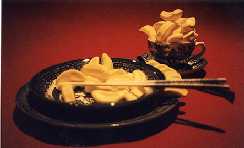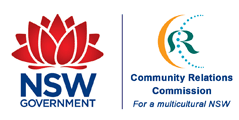I believe that institutional racism is a much greater problem in Australian society than we are prepared to acknowledge, and it informs behaviours without people even realising it – even in people who think they are embracing a multicultural society. My “story” is a discussion of my observations and experiences as a first-generation, Asian-Australian woman through an artwork I produced for an exhibition in Munich, Germany.
The following ‘story’ is actually a commentary about an artwork I produced for an exhibition about racism in a gallery in Munich. The artwork was called “(Asian)-Aussie Aussie Aussie Oi Oi Oi”, and it addressed my personal observations/experiences on Australia’s attitude to multiculturalism, political correctness and national pride. The work combines personal histories and experiences with a questioning of how the dominant white culture perceives the “Other”. The artwork also relies on a series of stereotyped and thus, recognisable cultural motifs, combined and layered in a visually humorous, but poignant way.
(Asian)-Aussie Aussie Aussie Oi Oi Oi
After a decade of healthy economic growth, which was achieved, fed and sustained by successful tourism campaigns in the USA, Europe, Japan and Asia, Australia has now found itself in an ambiguous state of denial about the impact of Pauline Hanson’s One Nation Party. One Nation, under the guise of striving for Equality for all Australians, has at its core, a white supremacist attitude that fails to acknowledge or appreciate difference and diversity. It refuses to recognise that Australia must become part of a global culture in order to survive, and instead shirks all responsibility and blames Australia’s social, economic and environmental problems on migrants and indigenous Australians.
Many Australians were genuinely shocked by the rapid and seemingly unopposed rise of Hansonism. In an attempt to alleviate this shock, Australia’s media shared and exposed the variety of emotional states and political perspectives held by its citizens. The headlines and reports included:
“Amazed – Appalled – Disgusted – Offended – No comment – It’s about time – Too right – She is a handsome woman – Fish and chip shop owner tells it like it is – They should all go back to where they came from – Asian tourists vote No on Australia – They take our university places – International Asian students mass withdrawal from Australian universities – At least it’s out in the open and people are discussing it – Asian students assaulted – Asian students arrested – Asian student killed in racially motivated attack”\
Political correctness
So why is it that Hanson’s particular display of racism came as such a shock to so many people? It is because it was expressed within the forbidden realm of the public sphere. Australia has, like many other countries, suffered immensely from the impact of the early ’80s solution to extreme liberal guilt, the construct known as ‘Political Correctness’. Hanson’s public displays inspired others to come forward and provided them with the one thing they had been denied, a “legitimate” forum.
Hanson’s One Nation Party is once again receiving much exposure and public support, and so it is time for Australia to recognise this fundamental truth – that superficial public displays of political correctness have no positive impact on Australian society. Instead, PC behaviour has been used to obscure people’s abilities to comprehend the social reality in which they exist. PC redirects the focus away from an examination of the inherent racial constructs fundamental to the practices of the dominant culture, and leaves us instead with confused liberal guilt symptoms. Thanks to PC, the reality that National Identity/ National Pride and racism are inherently linked almost always goes unrecognised.
The Australian public sphere language of PC – a sociologically determined language, designed and defined by the dominant culture for the comfort of the dominant culture – teaches individuals to utilise ‘inoffensive’ or ‘culturally appropriate’ language within the public space, however it doesn’t help individuals to learn to recognise and respect cultural differences, nor does it impact on the racist attitudes maintained within the private sphere.
Australian PC by design, utilises deception rather than comprehension as its fundamental characteristic. This allows for the continuance of Institutional and private sphere racism, while still maintaining/ presenting a global identity of, at least, a multi-culturally tolerant society, and at most, a multi-culturally embracing society.
Australians reactions to Hansonism highlights the duality of the PC existence, and it also unintentionally exposes to the rest of the world a problem that is present in each of their own back yards.
Multiculturalism is simply a process, it is not the final goal. Within the current western hierarchical social structure, the expression of multiculturalism will always be dictated by the dominant cultural structure. (So ‘other cultures’ become validated only by their alignment with white culture, and are denied any inherent value, or right to exist, outside of these defined boundaries of acceptable multiculturalism). While some celebrate/exoticise cultural difference, others force assimilation (“one of us”), while yet others blatantly emphasise their assumed superiority. A healthy multicultural society respects cultural difference, but also continues to question the validity of all cultural traditions being practised, especially the dominant culture, in relation to progressive contemporary existence and to the rights of the individual.
In Australia today, people of NESB (Non English Speaking Backgrounds – the PC term!) are encouraged to “fit in” by displays of patriotism, ie become more acceptable by acting Aussie. Yet no matter how good an actor, the experience of being Other-ed is the most common. In this, the first era of globalisation, the concept of a monoculture – especially a global monoculture – is still feared, fuelled by the belief that one’s culture is one’s identity.
This artwork, “(Asian)-Aussie Aussie Aussie Oi Oi Oi” explores the dangerous intersections between concepts of national identity, national pride/ patriotism and racism. The work combines personal histories and experiences with a questioning of how the dominant white culture perceives the “Other”. The work relies on a series of stereotyped and thus, recognisable cultural motifs, combined and layered in a visually humorous, but poignant way.
The motifs:
“(Asian)-Aussie Aussie Aussie Oi Oi Oi” is a manipulation of the Australian sporting cheer. Especially after the 2000 Olympics, the world seems to believe that sport defines Australian culture. This title references common experiences of growing up Asian-Australian – the hyphenated uncertainty of cultural identity and the need to display overtly patriotic behaviour in order to go some way in being accepted by the dominant culture, the expected subordination of Asian women, and the “banana” experience of not sitting comfortably inside your own skin – experiencing exclusion from both cultures.
The cheongsam is the most recognisable symbol of the Chinese woman. It conjures up images of the Asian woman as exotic, beautiful, sensual, and also compliant and submissive. Especially in Australia where ‘sex tours’ to Asian countries or purchasing an Asian mail-order bride are still socially accepted, Asian women are stereotyped as submissive. This cheongsam is constructed from vertical strips of green, gold and white Chinese embroidered satin, reflecting the appearance of Rugby League team sporting jerseys. In this work, the cheongsam extends to become a tablecloth, emphasising the servitude and essentially voiceless roles of Asians who do not elect to “fit in”.
Rugby League Player ’9′: Green and Gold are the Aussie sporting colours (gold and white refer to the “banana”). In Chinese culture, the number 9 reflects eternity and power. In western numerology, 9 represents the completion of one cycle and the creation of another – a new beginning and a new way of viewing the world after learning from the past. The player that wears the number 9 jersey in Rugby League, is the Hooker. The hooking role has changed over the years. It used to be an important skill of hooking the ball during the scrum but with the changes in rules, is now more a defending and dummy-half role – the hooker role is essentially a defunct role. Hooker is also slang for a prostitute – another reference to the expected submission of Asian women in Australian society.
In this work, 9 suggests all these concepts – that the struggle to achieve a truly global culture does require commitment and determination by all, but the struggle means that we grow as a society to create a world that is rich, diverse and functional.
A schooner glass is filled with candy bananas. A Banana is an expression for someone who is “Yellow on the outside and white on the inside”. I have traced the term back to mainland Chinese, who used it as a derogatory term for Asians who have been brought up in “white society” and have not maintained traditional Chinese values. It continues to be a derogatory term for Asians in Australia. The Banana also has connotations with “Aussie Identity” (Australian’s have a passion for BIG tourist icons, and in Coffs Harbour, a popular sunny tourist destination, the icon is The Big Banana, a tourist museum!). The Banana also refers to the goldrush era in Australia, when the Chinese came to Australia to seek their fortune and were victims of both violent race-motivated murders (the diggers argued that the Chinese were taking opportunities away from Europeans – interestingly, this is a position that the One Nation Party still maintains over 150 years later), and Institutionalised racism (they were denied Panning permits by the government to deter them from arriving in Australia). However, it was the ingenuity of the Chinese to set up market gardens, especially in Queensland, that saved the diggers from malnutrition and scurvy!
I am interested in the theme of food, and how Difference is made “palatable” to the dominant culture, the consumer of a Multicultural Product. Sickly sweet. In this artwork, the BANANAs trapped in the schooner glass, are a symbol of the identity struggle for those who are bi- or trans-cultural, being forced to adopt a glass skin to hide who they really are.
Can of VB is a symbol of “Aussie mateship”, uncensored expression against authority figures and showing the Aussie battler spirit. In this work, it represents the link between national pride/ patriotism and racist behaviour.
The Pub environment – In Wollongong (where I live) one of the prominent and most powerful motorcycle gangs calls themselves the “Fourth Reich”. Even though I have been told that their ‘politics’ are not like that of the Third Reich, and it’s “just a name”, they have taken over a local pub as their hangout. So I no longer go to this pub, as their opinions, expressed freely and openly and brashly, are not opinions that I agree with …


